| |
| |
|
|
| |
|
|
| |
|
|
| |
|
| |
|
|
| |
|
Flow Visualization at Cryogenic Conditions Using a Modified Pressure Sensitive paint Approach
+ Download |
| |
|
|
| |
|
|
Pressure and Temperature Sensitive Paint
PSP and TSP measurement techniques allow the recovery of global pressure and temperature distributions on aerodynamic test articles. PSP measurements exploit the susceptibility of luminescent probe molecules to collisional deactivation, or quenching, by molecular oxygen (O2). A PSP is produced by dispersing a luminescent probe (luminophore) within a gas-permeable polymeric binder material that is sprayed onto a test-article of interest. In operation, the PSP is illuminated with blue or UV light, and the intensity of the resulting red-shifted emission is inversely proportional to the pressure (i.e., partial pressure of oxygen) and temperature at the surface. To account for non-uniformity in the paint application and illumination field, CCD image data acquired at condition (wind on) are ratioed with reference image data acquired under no-flow (wind-off) conditions. The resulting intensity-ratio data is then converted to pressure by applying an a priori calibration acquired in a laboratory calibration cell.
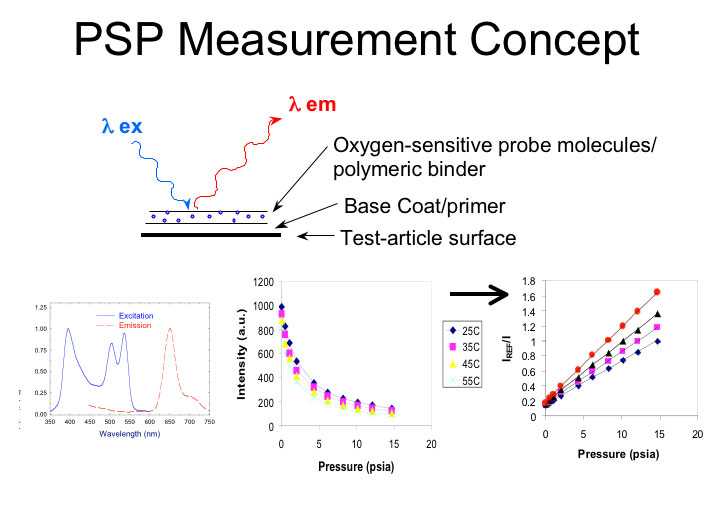
An alternative method for acquiring PSP data is the “lifetime” approach, in which the paint is illuminated with a short pulse of light (typically from 10-30 ms in width) and two images acquired. The first image is acquired during the excitation pulse or immediately following it (when pressure and temperature sensitivity is at a minimum), and the second image is acquired at a finite time after the excitation pulse (typically 5-10 ms after the pulse). The advantage to this technique is that all data is acquired at condition, significantly easing the data analysis process.
Applications:
PSP has been used extensively for a variety of application in many different facilities at NASA Langley Research Center as well as world-wide. It has been used in a variety of speed regimes, including low speed automotive and airframe applications, transonic, and hypersonic speeds.
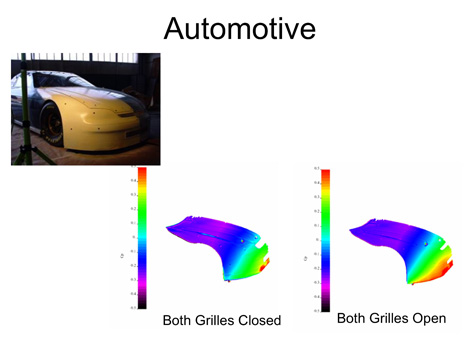 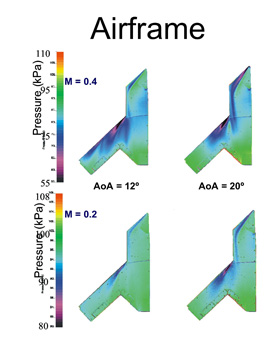
 
PSP is also finding uses in other areas, such as measuring surface pressures on rotorcraft blades (figure). A modification of the technique was also employed in a cryogenic facility to create virtual “streamlines” to visualize flow in and above the boundary layer on a model surface (figure).
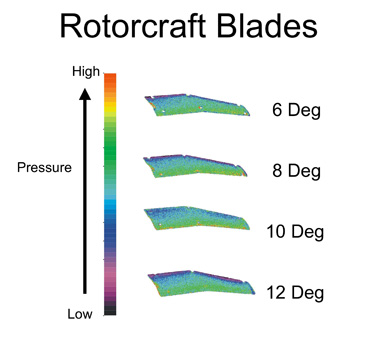 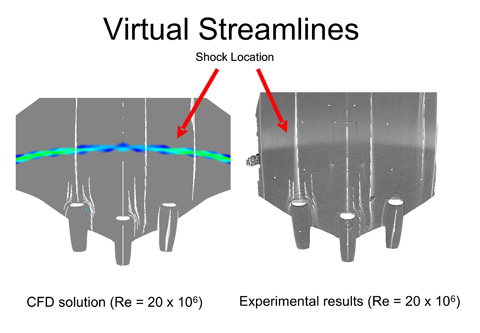
TSP provides a means to visualize flow transition on a surface as well as calculate properties such as heat transfer. Recently, TSP was used to measure the heating due t o Reaction Control System jets firing on a capsule re-entry model in support of the Constellation program. o Reaction Control System jets firing on a capsule re-entry model in support of the Constellation program.
Selected Publications:
- J.D. Jordan, A.N. Watkins, G.A. Fleming, B.D. Leighty, R.J. Schwartz, J.L. Ingram, K.D. Grinstead, D.M. Oglesby, and C. Tyler, “Rapid Technology Assessment via Unified Deployment of Global Optical and Virtual Diagnostics,” presented at the 20th International Congress on Instrumentation in Aerospace Simulation Facilities, Aug. 25-29, 2003, Gottingen, Germany.
- A.N. Watkins, J.D. Jordan, B.D. Leighty, J.L. Ingram, and D.M. Oglesby, “Development of Next Generation Lifetime PSP Imaging Systems,” presented at the 20th International Congress on Instrumentation in Aerospace Simulation Facilities, Aug. 25-29, 2003, Göttingen, Germany.
- D.M. Oglesby, J.L. Ingram, J.D. Jordan, A.N. Watkins, and B.D. Leighty, “Water Based Pressure Sensitive Paint,” NASA Technical Memorandum TM-2004-213268.
- A.N. Watkins, W.K. goad, C.J. Obara, D.R. Sprinkle, R.L. Campbell, M.B. Carter, O.C. Pendergraft, Jr., J.H. Bell, J.L. Ingram, D.M. Oglesby, P.J. Underwood, and L.R. Humber, “Flow Visualization at Cryogenic Conditions Using a Modified Pressure Sensitive paint Approach,”presented at the 43rd AIAA Aerospace Sciences meeting and Exhibit, Jan. 10-13, 2005, Reno, NV, and published as AIAA-2005-0456.
- O.D. Wong, A.N. Watkins, and J.L. Ingram, “Pressure Sensitive Paint Measurements on 15% Scale Rotor Blades in Hover,” presented at the 35th AIAA Fluid Dynamics Conference and Exhibit, June 6-9, 2005, Toronto, Ontario, Canada, and published as AIAA-2005-5008.
- K.J. Murphy, S.E. Borg, A.N. Watkins, D.R. Cole, and R.J. Schwartz, “Testing of the Crew Exploration Vehicle in NASA Langley’s Unitary Plan Wind Tunnel,” presented at the 45th AIAA Aerospace Sciences meeting and Exhibit, Jan. 8-11, 2007, Reno, NV, and published as AIAA-2007-1005.
- A.N. Watkins, B.D. Leighty, W.E. Lipford, O.D. Wong, D.M. Oglesby, and J.L. Ingram, “Development of a Pressure Sensitive paint System for Measuring Global Surface Pressures on Rotorcraft Blades,” presented at the 22nd International Congress on Instrumentation in Aerospace Simulation Facilities, June 11-14, 2007, Pacific Grove, CA, and published in the proceedings.
- A.N. Watkins, G.M. Buck, B.D. Leighty, W.E. Leighty, and D.M. Oglesby, “Using Pressure- and Temperature-Sensitive Paint for Global Surface Pressure and Temperature Measurements on the Aft-Body of a Capsule Reentry Vehicle,” presented at the 46th AIAA Aerospace Sciences meeting and Exhibit, Jan. 7-10, 2008, Reno, NV, and published as AIAA-2008-1230.
|




